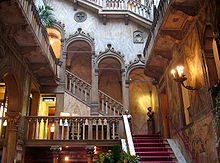Maud de Belleroche
Maud de Belleroche (born August 26, 1922 in Paris as Madeleine Sacquard , † February 19, 2017 in Villerville ) was a French film actress , writer and journalist . During the Second World War she had numerous acquaintances in collaboration circles .
Life
Early years
She was born in 1922 in the 17th arrondissement of Paris into a Catholic family. Her father lost an arm in the Battle of Chemin des Dames in World War I and was awarded the Croix de guerre and a military medal. As a child, she achieved remarkable sporting achievements: she became a French junior figure skating champion and a record holder in diving. She was later referred to in the historical magazine La Nouvelle Revue d'histoire as "fascist Egeria ".
She enjoyed a Catholic upbringing from the Marists , passed her baccalaureate at the age of 16 and studied pharmacology for two years before completing her first law degree.
She was married a total of three times, the first time to a pharmacist named Gaston Dacquin. The wedding took place on November 27, 1940 in Saint-Leu-d'Esserent .
Second World War
In German-occupied France , she was a mistress of Jean Luchaire (1901-1946, son of Julien Luchaire ), who was shot as a collaborator after the war. She described Jean Luchaire as the greatest dandy of the politicians of the time and made friends with other influential collaborators such as Pierre Drieu la Rochelle and Robert Brasillach . In August 1944 she followed Luchaire into German exile in Baden-Baden and Sigmaringen , where she met Celine and his wife Lucette and worked as an assistant in a pharmacy .
After the collaborator Georges Guilbaud was appointed Ministre plénipotentiaire of the government-in-exile of the Vichy regime in the Italian Social Republic , she followed him to Italy in autumn 1944 and married him one month after their arrival, with Guido Buffarini-Guidi and Rudolf Rahn as witnesses. She supported French refugees, received guests like Joseph Darnand and had a long conversation with Mussolini in December 1944 . With her second husband she visited the Vittoriale , D'Annunzio's residence , and Venice , where they resided in the Hotel Danieli, the former Palazzo Dandolo . When the death of Jacques Doriot became known in March 1945 , the refugee collaborators of the Vichy regime felt too hot in Italy. Maud and Guilbaud received forged Swiss papers and were initially captured by Italian partisans , but were able to escape and cross the border to Switzerland , from where they were allowed to return to France.
Post-war years
On her return journey to France, she was arrested while leaving the train and spent a few days in a prison in Lyon . She was rehabilitated, returned to Paris and met Gaston Palewski at the Hotel Matignon , whom she asked for a visa for Spain. She secretly crossed the border at Canet-en-Roussillon and reached Madrid via Barcelona , where she met Guilbaud again . Here she met Émile Dewoitine and Abel Bonnard , who visited the Prado and the Casa de las Conchas in Salamanca with her and explained the Plateresque style to her , and became the female tennis champion of Castile .
In 1946 she followed her husband to Argentina , where he became administrative advisor to President Juan Perón , and married for the third time in Paris in 1950, this time Jacques Chastelain, Baron von Belleroche. In later years she gave lectures for the Alliance française and other organizations and retired to Normandy .
Work and effect
Your writing activity falls into the post-war years. She wrote monographs on Oscar Wilde , Sacha Guitry and Eva Perón , among others . For the novel Cinq personnages en quête d'empereur ("Five people in search of an emperor"), which appeared in 1962, she received an award from the Académie française in 1963 . In her erotic novel L'Ordinatrice , published in 1968 , with the subtitle Memoirs of a Forty-Year-Old Woman , she describes her male and female conquests. In Le Ballet des crabes , she represented anti-Semitic views.
In 1969 she appeared in the Italian erotic film Top Sensation , directed by Ottavio Alessi . She inspired Louis-Ferdinand Céline in his novel “Nord” (1960) to the person of Mademoiselle de Chamarande .
Individual evidence
- ↑ VILLERVILLE NEWS p. 8
- ↑ Les aventuriers de XXe siècle
- ^ Directory of the Académie française
- ↑ Der Spiegel, July 22, 1968
Web links
| personal data | |
|---|---|
| SURNAME | Belleroche, Maud de |
| ALTERNATIVE NAMES | Sacquard, Madeleine (maiden name) |
| BRIEF DESCRIPTION | French film actress, writer and journalist |
| DATE OF BIRTH | August 26, 1922 |
| PLACE OF BIRTH | Paris |
| DATE OF DEATH | 19th February 2017 |
| Place of death | Villerville |
